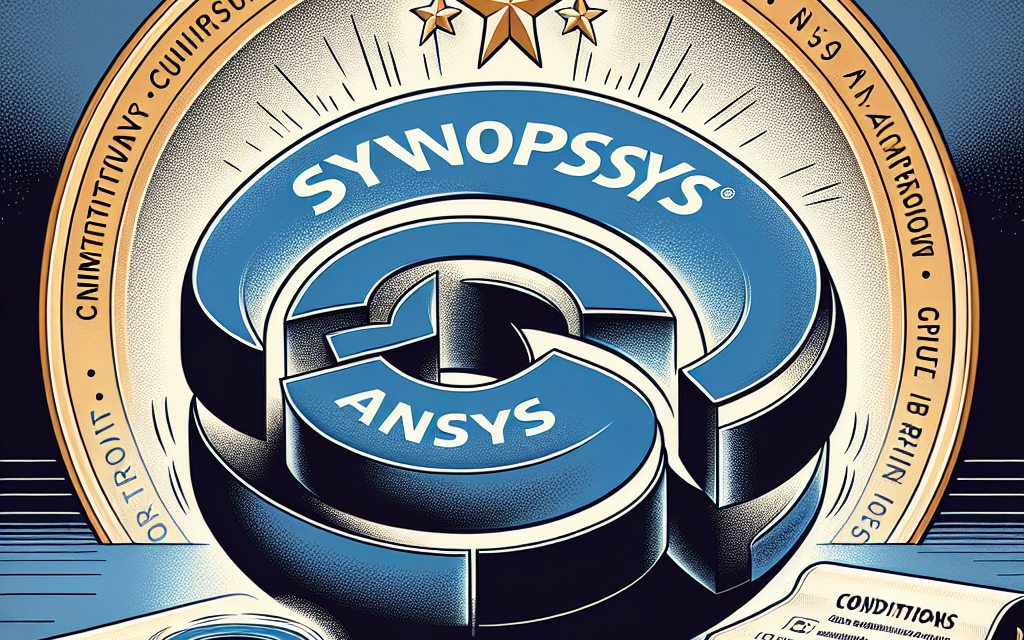“EU Greenlights Synopsys’ $35 Billion Ansys Acquisition with Strategic Conditions for Market Fairness.”
Introduction
The European Union’s competition authority has granted conditional approval for Synopsys’ $35 billion acquisition of Ansys, a significant move in the semiconductor and software industries. This decision comes after a thorough investigation into the potential impact of the merger on market competition and innovation. To address concerns regarding reduced competition in certain areas, the EU has imposed specific conditions that Synopsys must adhere to, ensuring that the acquisition does not stifle competition or harm consumers. This approval marks a pivotal moment for both companies, as they seek to enhance their capabilities and offerings in a rapidly evolving technological landscape.
Overview of the Acquisition: Synopsys and Ansys
In a significant development within the technology sector, the European Union’s competition authority has granted approval for Synopsys’ acquisition of Ansys, a deal valued at $35 billion. This acquisition marks a pivotal moment for both companies, as it aims to enhance their capabilities in the increasingly competitive landscape of electronic design automation (EDA) and simulation software. Synopsys, a leader in EDA solutions, has long been recognized for its innovative tools that facilitate the design and verification of complex semiconductor devices. Meanwhile, Ansys has established itself as a premier provider of engineering simulation software, enabling organizations to predict how products will perform in real-world conditions. The convergence of these two powerhouses is expected to create a formidable entity capable of delivering comprehensive solutions that span the entire product development lifecycle.
However, the approval from the EU competition authority comes with specific conditions aimed at addressing potential antitrust concerns. The authority’s scrutiny of the acquisition reflects a broader commitment to maintaining competitive markets, particularly in sectors where innovation is critical. By imposing these conditions, the EU seeks to ensure that the merger does not stifle competition or limit the choices available to customers in the EDA and simulation software markets. This careful oversight underscores the importance of fostering an environment where multiple players can thrive, ultimately benefiting consumers and driving technological advancements.
As the acquisition progresses, it is essential to consider the strategic rationale behind this move. For Synopsys, acquiring Ansys represents an opportunity to broaden its product offerings and enhance its technological capabilities. By integrating Ansys’ simulation tools with its own EDA solutions, Synopsys aims to provide a more holistic approach to product design and development. This integration is expected to streamline workflows for engineers and designers, allowing them to simulate and validate their designs more efficiently. Furthermore, the combined expertise of both companies could lead to the development of innovative solutions that address the evolving needs of industries such as automotive, aerospace, and consumer electronics.
Moreover, the acquisition is poised to create synergies that could drive cost efficiencies and accelerate research and development efforts. By leveraging Ansys’ advanced simulation technologies alongside Synopsys’ robust EDA tools, the newly formed entity could enhance its competitive edge in the market. This strategic alignment not only positions Synopsys to better serve its existing customer base but also opens doors to new markets and opportunities for growth. As industries increasingly rely on sophisticated design and simulation capabilities, the combined strengths of Synopsys and Ansys could prove invaluable in meeting these demands.
In conclusion, the approval of Synopsys’ acquisition of Ansys by the EU competition authority, albeit with conditions, signifies a transformative moment in the technology sector. This merger is not merely a financial transaction; it represents a strategic alignment of two industry leaders with the potential to reshape the landscape of electronic design automation and simulation software. As the integration process unfolds, stakeholders will be keenly observing how the combined entity navigates the challenges and opportunities that lie ahead. Ultimately, the success of this acquisition will depend on its ability to foster innovation while maintaining a competitive marketplace that benefits all participants.
Key Conditions Imposed by the EU Competition Authority
The recent approval by the European Union Competition Authority of Synopsys’ $35 billion acquisition of Ansys marks a significant development in the technology sector, particularly in the realm of electronic design automation (EDA) and simulation software. However, this approval comes with a set of key conditions aimed at ensuring that competition within the market remains robust and that consumers are not adversely affected by the consolidation of these two major players. The EU’s decision reflects a careful balancing act between fostering innovation through mergers and safeguarding competitive dynamics in the industry.
One of the primary conditions imposed by the EU Competition Authority is the requirement for Synopsys to divest certain assets related to its simulation software. This divestiture is intended to maintain a competitive landscape by preventing Synopsys from monopolizing critical technologies that could stifle innovation and limit choices for customers. By mandating the sale of specific software tools, the EU aims to ensure that other companies can continue to compete effectively in the market, thereby promoting a diverse ecosystem of EDA solutions.
In addition to the divestiture requirement, the EU has stipulated that Synopsys must provide access to its proprietary technology to third-party developers. This condition is designed to facilitate interoperability and integration among various software platforms, which is essential for companies that rely on multiple tools for their design and simulation processes. By allowing third-party developers to access Synopsys’ technology, the EU seeks to encourage innovation and collaboration within the industry, ultimately benefiting end-users who demand more versatile and efficient solutions.
Furthermore, the EU Competition Authority has emphasized the importance of maintaining transparency in pricing and licensing practices. To this end, Synopsys is required to commit to fair pricing structures for its software products, ensuring that customers are not subjected to exorbitant fees or unfair terms. This condition is particularly relevant in a market where software costs can significantly impact the operational budgets of companies, especially smaller firms that may struggle to compete against larger entities. By enforcing transparent pricing, the EU aims to create a more equitable environment for all market participants.
Moreover, the EU has mandated that Synopsys establish a monitoring mechanism to oversee compliance with these conditions. This oversight will involve regular reporting to the EU authorities, ensuring that Synopsys adheres to the commitments made during the acquisition process. Such monitoring is crucial for maintaining accountability and ensuring that the conditions imposed are not merely formalities but are actively enforced to protect competition in the long term.
In conclusion, while the EU Competition Authority’s approval of Synopsys’ acquisition of Ansys represents a significant milestone in the technology sector, it is accompanied by stringent conditions designed to preserve competitive integrity. The divestiture of certain assets, the requirement for technology access, the emphasis on transparent pricing, and the establishment of a compliance monitoring mechanism collectively reflect the EU’s commitment to fostering a competitive environment. As the industry evolves, these conditions will play a pivotal role in shaping the dynamics of the EDA and simulation software market, ensuring that innovation continues to thrive while safeguarding the interests of consumers and smaller competitors alike. The careful scrutiny applied by the EU serves as a reminder of the delicate balance between consolidation and competition in an increasingly interconnected global economy.
Implications for the Semiconductor Industry
The recent approval by the European Union’s competition authority of Synopsys’ $35 billion acquisition of Ansys carries significant implications for the semiconductor industry, a sector that is already navigating a complex landscape of technological advancements and competitive pressures. This acquisition, while promising to enhance the capabilities of both companies, raises important questions about market dynamics, innovation, and regulatory oversight in an industry that is critical to global economic growth.
To begin with, the merger is expected to create a more formidable entity in the electronic design automation (EDA) space, where both Synopsys and Ansys have established themselves as leaders. By combining their resources and expertise, the newly formed organization is likely to accelerate the development of advanced simulation and design tools that are essential for semiconductor manufacturing. This could lead to improved efficiencies and reduced time-to-market for new semiconductor products, which is particularly crucial given the rapid pace of technological change and the increasing demand for more sophisticated chips.
However, the approval comes with conditions aimed at preserving competition within the market. The European Commission has mandated that Synopsys must ensure that its software remains accessible to other semiconductor companies, particularly smaller firms that may lack the resources to develop their own tools. This stipulation is vital, as it aims to prevent the potential monopolization of critical EDA tools that could stifle innovation and limit choices for semiconductor manufacturers. By maintaining a competitive landscape, the EU is fostering an environment where diverse players can thrive, ultimately benefiting the entire industry.
Moreover, the acquisition underscores the growing trend of consolidation within the semiconductor sector. As companies seek to enhance their technological capabilities and expand their market reach, mergers and acquisitions have become a common strategy. This trend raises concerns about the long-term implications for competition and innovation. While larger entities may have the resources to invest in research and development, there is a risk that smaller, innovative firms could be overshadowed or driven out of the market. The EU’s conditional approval serves as a reminder of the delicate balance that must be maintained to ensure that competition remains robust.
In addition to the competitive landscape, the acquisition also highlights the increasing importance of software in semiconductor design and manufacturing. As chips become more complex, the role of sophisticated simulation tools becomes paramount. The integration of Synopsys’ and Ansys’ technologies could lead to breakthroughs in areas such as artificial intelligence, machine learning, and Internet of Things (IoT) applications, which are all heavily reliant on advanced semiconductor capabilities. Consequently, the merger could catalyze a new wave of innovation that propels the industry forward.
Furthermore, the approval of this acquisition may set a precedent for future mergers in the semiconductor space. As regulatory bodies around the world scrutinize large-scale acquisitions, the conditions imposed by the EU could influence how similar deals are evaluated in the future. Companies contemplating mergers will need to consider not only the potential benefits of consolidation but also the regulatory hurdles they may face. This evolving landscape necessitates a strategic approach to mergers and acquisitions, one that prioritizes compliance with competition laws while still pursuing growth opportunities.
In conclusion, the EU’s approval of Synopsys’ acquisition of Ansys, albeit with conditions, signals a pivotal moment for the semiconductor industry. It emphasizes the importance of maintaining competition while fostering innovation and highlights the critical role of software in shaping the future of semiconductor design and manufacturing. As the industry continues to evolve, stakeholders must remain vigilant in balancing the benefits of consolidation with the need for a competitive marketplace that encourages diverse contributions and technological advancements.
Impact on Innovation and Competition
The recent approval by the European Union’s competition authority of Synopsys’ $35 billion acquisition of Ansys, albeit with specific conditions, marks a significant moment in the landscape of technology and innovation. This decision not only reflects the regulatory body’s commitment to maintaining competitive markets but also highlights the intricate balance between fostering innovation and preventing monopolistic practices. As the technology sector continues to evolve rapidly, the implications of such large-scale mergers extend far beyond the immediate financial figures involved.
Firstly, it is essential to recognize that the merger between Synopsys, a leader in electronic design automation (EDA), and Ansys, renowned for its simulation software, has the potential to create a powerhouse in the realm of engineering and design tools. By combining their resources and expertise, the two companies can enhance their product offerings, streamline operations, and ultimately deliver more advanced solutions to their customers. This synergy could lead to accelerated innovation, as the integration of their technologies may result in the development of cutting-edge tools that push the boundaries of what is currently possible in design and simulation.
However, the EU’s conditional approval underscores the authority’s vigilance in ensuring that such mergers do not stifle competition. The conditions imposed are likely aimed at preserving a diverse marketplace where smaller firms can thrive alongside industry giants. This is particularly important in the technology sector, where innovation often springs from smaller companies that challenge established players. By maintaining a competitive environment, the EU aims to encourage a continuous flow of new ideas and technologies, which is crucial for long-term growth and advancement in the industry.
Moreover, the conditions set forth by the EU may also serve to mitigate potential risks associated with the merger. For instance, ensuring that competitors have access to essential technologies and resources can prevent Synopsys from leveraging its enhanced market position to unfairly disadvantage rivals. This approach not only protects existing competition but also fosters an ecosystem where innovation can flourish. In this context, the EU’s decision can be seen as a proactive measure to safeguard the interests of consumers and smaller companies alike.
In addition to the immediate effects on competition, the merger’s approval may have broader implications for the global technology landscape. As companies like Synopsys and Ansys consolidate their capabilities, they may set new standards for innovation that could influence industry practices worldwide. This could lead to a ripple effect, prompting other firms to adapt and innovate in response to the enhanced offerings resulting from the merger. Consequently, the approval may catalyze a wave of advancements across various sectors, as companies strive to keep pace with the evolving capabilities of their competitors.
Furthermore, the merger could also impact investment trends within the technology sector. Investors often look favorably upon consolidations that promise enhanced efficiencies and innovation potential. As Synopsys and Ansys embark on this new chapter, their ability to deliver on the promises of improved products and services will be closely monitored by stakeholders. If successful, this merger could inspire confidence in similar transactions, potentially leading to a series of strategic acquisitions aimed at fostering innovation and growth.
In conclusion, while the EU’s approval of Synopsys’ acquisition of Ansys with conditions is a pivotal development, its true impact on innovation and competition will unfold over time. By balancing the need for consolidation with the imperative of maintaining a competitive marketplace, the EU has set a precedent that could shape the future of technology and innovation for years to come.
Reactions from Industry Experts and Stakeholders
The recent approval by the European Union’s competition authority of Synopsys’ $35 billion acquisition of Ansys has elicited a range of reactions from industry experts and stakeholders, reflecting the complexities and implications of such a significant merger in the technology sector. While the approval is a pivotal moment for both companies, it comes with specific conditions aimed at ensuring fair competition in the market. This decision has sparked discussions among analysts, competitors, and customers, each of whom views the merger through different lenses.
Industry experts have generally welcomed the acquisition, recognizing the potential for enhanced innovation and improved product offerings that could arise from the combination of Synopsys’ and Ansys’ capabilities. Many believe that the merger will create a more robust entity capable of delivering advanced solutions in electronic design automation and simulation software. This sentiment is echoed by several analysts who argue that the integration of resources and expertise could lead to significant advancements in technology, particularly in areas such as artificial intelligence and machine learning, which are becoming increasingly vital in engineering and design processes.
However, the approval has not been without its critics. Some stakeholders express concerns regarding the potential for reduced competition in the market. The conditions imposed by the EU competition authority, which include commitments to maintain interoperability and access to essential tools for competitors, are seen as necessary safeguards. Critics argue that while these conditions may mitigate some risks, they may not fully address the long-term implications of such a large-scale consolidation. The fear is that the merger could lead to a monopolistic environment where smaller players struggle to compete, ultimately stifling innovation rather than fostering it.
Moreover, customers of both Synopsys and Ansys have voiced mixed reactions. On one hand, some customers are optimistic about the potential for improved products and services resulting from the merger. They anticipate that the combined expertise of both companies will lead to more comprehensive solutions that better meet their needs. On the other hand, there are apprehensions regarding the integration process and how it might affect existing contracts, support services, and product development timelines. Customers are particularly concerned about the continuity of service and the potential for disruptions during the transition period.
In addition to customer concerns, competitors are closely monitoring the situation. Some view the merger as a strategic move that could reshape the competitive landscape, prompting them to reevaluate their own strategies in response. The conditions set forth by the EU may serve as a blueprint for how future mergers and acquisitions in the tech sector are approached, particularly regarding the balance between fostering innovation and maintaining competitive markets. Competitors may feel pressured to innovate more rapidly or seek partnerships to bolster their offerings in light of the enhanced capabilities that Synopsys and Ansys will bring to the table.
In conclusion, the reactions to the EU’s approval of Synopsys’ acquisition of Ansys reveal a multifaceted landscape of opinions and concerns. While there is optimism about the potential for innovation and improved solutions, there are also significant apprehensions regarding competition and market dynamics. As the integration process unfolds, it will be crucial for all stakeholders to remain engaged and vigilant, ensuring that the benefits of this merger are realized without compromising the competitive integrity of the industry. The coming months will undoubtedly be pivotal in determining the long-term impact of this acquisition on the technology sector as a whole.
Historical Context of Mergers in the Tech Sector
The landscape of mergers and acquisitions in the technology sector has evolved significantly over the past few decades, reflecting broader economic trends, technological advancements, and regulatory responses. Historically, the tech industry has been characterized by rapid innovation and fierce competition, which often drives companies to seek strategic partnerships or acquisitions to enhance their market position, expand their product offerings, or gain access to new technologies. This trend has been particularly pronounced in the software and semiconductor industries, where the pace of change is relentless, and the need for continuous innovation is paramount.
In the late 1990s and early 2000s, the tech sector witnessed a wave of mergers that reshaped the competitive landscape. Companies like AOL and Time Warner pursued ambitious combinations, driven by the promise of synergies and the potential to create comprehensive digital ecosystems. However, many of these mergers faced scrutiny from regulatory bodies, which were concerned about the implications for competition and consumer choice. The fallout from these high-profile deals underscored the importance of antitrust considerations in the tech sector, leading to a more cautious approach to mergers in subsequent years.
As the industry matured, the focus shifted towards consolidating market power among a few dominant players. The rise of tech giants such as Google, Amazon, and Facebook prompted regulators to closely examine their acquisition strategies, particularly as these companies sought to acquire smaller startups that could pose competitive threats or enhance their existing capabilities. This scrutiny has intensified in recent years, with regulatory authorities in the United States and Europe increasingly concerned about the implications of such acquisitions for competition and innovation. The European Union, in particular, has taken a proactive stance in evaluating mergers, often imposing conditions or outright blocking deals that it deems detrimental to market competition.
In this context, the recent approval of Synopsys’ $35 billion acquisition of Ansys by the EU Competition Authority, albeit with conditions, reflects the ongoing balancing act between fostering innovation and maintaining competitive markets. The deal, which aims to combine two leading players in the electronic design automation (EDA) space, highlights the strategic importance of mergers in the tech sector while also illustrating the regulatory challenges that accompany such transactions. The conditions imposed by the EU serve as a reminder that while consolidation can drive efficiencies and innovation, it must not come at the expense of competition.
Moreover, the historical context of mergers in the tech sector reveals a pattern of regulatory evolution in response to changing market dynamics. As technology continues to advance at an unprecedented pace, regulators are tasked with adapting their frameworks to address new challenges posed by digital markets. This includes not only traditional antitrust concerns but also issues related to data privacy, market access, and the potential for anti-competitive behavior in increasingly concentrated markets.
In conclusion, the approval of Synopsys’ acquisition of Ansys underscores the complex interplay between innovation, competition, and regulation in the tech sector. As companies continue to pursue strategic mergers to navigate a rapidly changing landscape, the role of regulatory authorities will remain critical in ensuring that these transactions promote healthy competition while fostering an environment conducive to innovation. The historical context of mergers in the tech sector serves as a valuable lens through which to understand the ongoing challenges and opportunities that lie ahead in this dynamic industry.
Future Prospects for Synopsys and Ansys Post-Acquisition
The recent approval by the European Union’s competition authority of Synopsys’ $35 billion acquisition of Ansys marks a significant milestone in the semiconductor and engineering software industries. This decision, however, comes with specific conditions aimed at ensuring fair competition and preventing potential monopolistic practices. As both companies move forward post-acquisition, the future prospects for Synopsys and Ansys appear promising, albeit with challenges that will require careful navigation.
In the wake of the acquisition, Synopsys is poised to enhance its portfolio significantly. By integrating Ansys’ advanced simulation software capabilities, Synopsys can offer a more comprehensive suite of tools that cater to the growing demands of the semiconductor industry. This integration is expected to foster innovation, allowing clients to streamline their design processes and improve product performance. As industries increasingly rely on sophisticated simulations to predict product behavior under various conditions, the combined strengths of Synopsys and Ansys will likely position them as leaders in this niche market.
Moreover, the acquisition is anticipated to create synergies that can lead to cost efficiencies and improved operational capabilities. By leveraging Ansys’ expertise in engineering simulation alongside Synopsys’ strengths in electronic design automation (EDA), the two companies can optimize their research and development efforts. This collaboration may result in faster time-to-market for new products, which is crucial in an industry characterized by rapid technological advancements. As a result, customers can expect enhanced solutions that not only meet but exceed their expectations.
However, the path forward is not without its hurdles. The conditions imposed by the EU competition authority necessitate that Synopsys maintain a level of transparency and accessibility in its offerings. This requirement is designed to ensure that competitors can still access essential tools and technologies, thereby fostering a competitive landscape. Consequently, Synopsys must strike a delicate balance between leveraging its enhanced capabilities and adhering to regulatory expectations. This balancing act will be critical in maintaining goodwill with both customers and regulators, as any misstep could lead to scrutiny or penalties.
Furthermore, the integration process itself presents its own set of challenges. Merging two large organizations with distinct corporate cultures and operational methodologies can be complex. Effective communication and change management strategies will be essential to ensure that employees from both companies are aligned and motivated. By fostering a collaborative environment, Synopsys can harness the collective expertise of both teams, ultimately driving innovation and enhancing customer satisfaction.
Looking ahead, the combined entity will also need to navigate the evolving landscape of technology and market demands. As industries such as automotive, aerospace, and consumer electronics increasingly adopt advanced technologies like artificial intelligence and machine learning, the need for sophisticated simulation tools will only grow. Synopsys and Ansys must remain agile, continuously adapting their offerings to meet these emerging needs. This adaptability will be crucial in maintaining their competitive edge and ensuring long-term success.
In conclusion, the future prospects for Synopsys and Ansys following the acquisition are filled with potential. While the integration of their capabilities promises to yield significant benefits for both companies and their customers, it also requires careful management of regulatory conditions and organizational dynamics. By focusing on innovation, collaboration, and responsiveness to market trends, Synopsys and Ansys can position themselves as formidable players in the engineering software and semiconductor industries, ultimately driving growth and value for stakeholders in the years to come.
Q&A
1. **What is the main subject of the EU Competition Authority’s decision?**
– The EU Competition Authority approved Synopsys’ $35 billion acquisition of Ansys with specific conditions.
2. **What are the conditions imposed by the EU Competition Authority?**
– The conditions typically involve divestitures or commitments to ensure fair competition in the market, although specific details would need to be referenced from the official announcement.
3. **Why was the acquisition scrutinized by the EU Competition Authority?**
– The acquisition raised concerns about potential monopolistic practices and reduced competition in the software market for electronic design automation (EDA).
4. **What is Synopsys known for?**
– Synopsys is a leading provider of electronic design automation software and services used in the semiconductor and electronics industries.
5. **What is Ansys known for?**
– Ansys specializes in engineering simulation software, which is used for product design and testing across various industries.
6. **What impact could this acquisition have on the market?**
– The acquisition could lead to enhanced product offerings and innovation but may also reduce competition if not properly regulated.
7. **What is the next step following the EU’s approval?**
– Synopsys will need to comply with the imposed conditions before the acquisition can be finalized and fully integrated.
Conclusion
The EU Competition Authority’s approval of Synopsys’ $35 billion acquisition of Ansys, albeit with conditions, underscores the regulatory body’s commitment to maintaining competitive markets while allowing significant mergers to proceed. The conditions likely aim to address potential anti-competitive concerns, ensuring that the acquisition does not stifle innovation or limit choices for consumers in the software and engineering sectors. This decision reflects a balanced approach to fostering industry consolidation while safeguarding market integrity.





